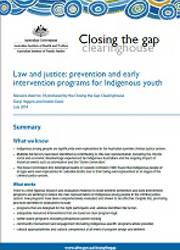Summary
What we know
- Indigenous young people are significantly over-represented in the Australian juvenile criminal justice system.
- Multiple risk factors have been identified as contributing to this over-representation, including the chronic social and economic disadvantage experienced by Indigenous Australians and the ongoing impact of historical events such as colonisation and the ‘Stolen Generation’.
- The Royal Commission into Aboriginal Deaths in Custody (Johnston 1991) found that Indigenous people of all ages were over-represented in custodial deaths due to their being over-represented at all stages of the criminal justice system.
What works
There is a little rigorous research and evaluation evidence to show whether prevention and early intervention programs are working to reduce the over-representation of Indigenous young people in the criminal justice system. Few programs have been comprehensively evaluated and shown to be effective. Despite this, promising practices identified in evaluations include:
- programs that are designed for the right participants and address identified risk factors
- adequately resourced interventions that are based on clear program logic
- family-based programs, including behavioural parent training
- community involvement and engagement (including Indigenous-specific programs where possible)
- cultural appropriateness and cultural competence at all levels of program design and delivery
Law and justice: prevention and early intervention programs for Indigenous youth
- effective collaboration across organisations and between Indigenous and non-Indigenous individuals and communities
- addressing multiple and complex needs by adopting a holistic and comprehensive approach.
What doesn’t work
It is difficult to assess and identify exactly what it is that is not working in the prevention and early intervention programs that target young people in Indigenous communities. Barriers to the effectiveness of such programs that have been highlighted in the research include:
- interventions that fail to integrate and actively engage with local Indigenous people at all stages (including development, implementation and evaluation)
- interventions that fail to take into account and target the multiple and complex issues that lead to offending (for example, alcohol and substance misuse, unemployment, lack of education)
- low levels of funding and staff resourcing that can limit the reach and effects of intervention programs.
What we don’t know
There is little empirical information about the effectiveness of either non-Indigenous specific (mainstream) or Indigenous-specific prevention and early intervention programs that address criminal justice system involvement. Although some programs have been implemented, only a small proportion of these have been evaluated, and there have been problems with the design and implementation of evaluations that do exist. Areas that require further in-depth research and evaluation include the following:
- How do Indigenous participants fare in mainstream programs? Often, the outcomes for Indigenous participants are not measured or recorded separately from non-Indigenous participants, so it is difficult to substantiate the usefulness and suitability of programs that are designed specifically for Indigenous young people.
- How sustainable are the outcomes, particularly the long-term outcomes? This requires much more rigorous data collection at all phases of program development, implementation and evaluation.
- Is collaborative case management in youth crime prevention and reduction programs effective for Indigenous young people?
- How effective are structured, cognitive behavioural programs based on ‘Western’ psychological theories— such as aggression replacement training—for Indigenous young people?
Summary
- What we know
- What we don’t know
Introduction
- The National Indigenous Law and Justice Framework
- Risk factors
- Types of intervention programs
- Promising practices
Gaps in the evidence
- Conclusion
Appendix
End matter: References; Acknowledgments; Terminology; Funding; Suggested citation; Copyright



